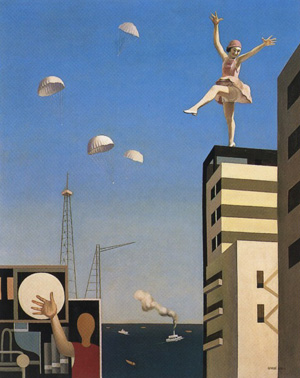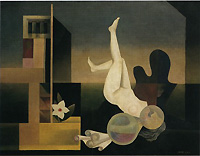The exhibition 'Koga Harue: Exploring the origins of his Art through his Works and Materials' offers a rare insight into the mind of the artist and his sources of inspiration. Through Koga's sketches, notebooks and background materials, including photographs and magazine images, we are given a unique glimpse into his creative process. Presented alongside the finished works to which they relate, this material is a valuable tool in understanding the art of this important early twentieth century artist.
Koga Harue (1895-1933) was part of a group of young artists who pioneered modernist art in Japan in the 1920 and 1930's. He was born in the city of Kurume in Fukuoka prefecture where his father was head of a Buddhist temple. In 1914, when Koga was 19, he went to Tokyo where he studied watercolor painting. However, he returned shortly afterwards, following the suicide of his Tokyo roommate. At the request of his father, Koga returned to his hometown to begin training for the priesthood.
He also continued to pursue his interest in painting. Koga was a poet as well as painter. He wrote of painting: "A watercolor is not a full length novel, a watercolor is a symbolical poem with a free and mellow but lonely and sentimental mood". Often Koga wrote poems by the same title as his paintings. 'Beautiful Fair' (pictured) is such a case. "A stream of color of young grass flows by, a glass dancer sinks deep below. She is the red gold fish in the water."
At first he painted primarily in watercolors and only later did he develop skills with oil paints. Koga's art reflected the influences of European artists, particularly the work of Pablo Picasso and Paul Klee. Later his art came under the influence of Surrealism. Koga avidly pursued new ideas and unexpected motifs and made use of such sources as magazine graphics, scientific journals, medical books and post cards. While Koga's work flirts with several European influences, it maintains a strong individual style. His paintings have a dreamy innocence and magical naivete about them.
This exhibition illustrates the range of sources he used for inspiration. Included are drawings Koga did working from a book by Hans Prinzhorn, 'Artistic Expressions of the Mentally Ill' (1922). This was a pioneer work dealing with creativity and psychotic personalities and contained many illustrations by mental patients. Koga Harue's copies of these drawings are of weird human forms, which later appear in some of his paintings.
The Koga Harue exhibition is a strong reason to visit the Bridgestone Museum of Art and a visit to this museum is always a richly rewarding experience as it has one of the finest collections of Japanese and European 20th century art outside Europe and the US. The Bridgestone's collection has recently been further enriched with the acquisition of 'Dune', a painting by Piet Mondrian. Painted in 1909 'Dune', an early work by Mondrian, is a small landscape in brightly colored dabs of oil paint. It is a little gem well worth wandering down the stellar galleries of Gauguins, Picassos and Matisses to glimpse.



